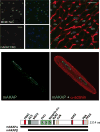mAKAP-a master scaffold for cardiac remodeling
- PMID: 25551320
- PMCID: PMC4355281
- DOI: 10.1097/FJC.0000000000000206
mAKAP-a master scaffold for cardiac remodeling
Abstract
Cardiac remodeling is regulated by an extensive intracellular signal transduction network. Each of the many signaling pathways in this network contributes uniquely to the control of cellular adaptation. In the last few years, it has become apparent that multimolecular signaling complexes or "signalosomes" are important for fidelity in intracellular signaling and for mediating crosstalk between the different signaling pathways. These complexes integrate upstream signals and control downstream effectors. In the cardiac myocyte, the protein mAKAPβ serves as a scaffold for a large signalosome that is responsive to cAMP, calcium, hypoxia, and mitogen-activated protein kinase signaling. The main function of mAKAPβ signalosomes is to modulate stress-related gene expression regulated by the transcription factors NFATc, MEF2, and HIF-1α and type II histone deacetylases that control pathological cardiac hypertrophy.
Figures


Similar articles
-
Bidirectional regulation of HDAC5 by mAKAPβ signalosomes in cardiac myocytes.J Mol Cell Cardiol. 2018 May;118:13-25. doi: 10.1016/j.yjmcc.2018.03.001. Epub 2018 Mar 6. J Mol Cell Cardiol. 2018. PMID: 29522762 Free PMC article.
-
The mAKAP signalosome and cardiac myocyte hypertrophy.IUBMB Life. 2007 Mar;59(3):163-9. doi: 10.1080/15216540701358593. IUBMB Life. 2007. PMID: 17487687 Review.
-
The scaffold protein muscle A-kinase anchoring protein β orchestrates cardiac myocyte hypertrophic signaling required for the development of heart failure.Circ Heart Fail. 2014 Jul;7(4):663-72. doi: 10.1161/CIRCHEARTFAILURE.114.001266. Epub 2014 May 8. Circ Heart Fail. 2014. PMID: 24812305 Free PMC article.
-
mAKAPβ signalosomes - A nodal regulator of gene transcription associated with pathological cardiac remodeling.Cell Signal. 2019 Nov;63:109357. doi: 10.1016/j.cellsig.2019.109357. Epub 2019 Jul 9. Cell Signal. 2019. PMID: 31299211 Free PMC article. Review.
-
mAKAPβ signalosome: A potential target for cardiac hypertrophy.Drug Dev Res. 2023 Sep;84(6):1072-1084. doi: 10.1002/ddr.22081. Epub 2023 May 18. Drug Dev Res. 2023. PMID: 37203301 Review.
Cited by
-
Myogenin controls via AKAP6 non-centrosomal microtubule-organizing center formation at the nuclear envelope.Elife. 2021 Oct 4;10:e65672. doi: 10.7554/eLife.65672. Elife. 2021. PMID: 34605406 Free PMC article.
-
Muscle A-kinase-anchoring protein-β-bound calcineurin toggles active and repressive transcriptional complexes of myocyte enhancer factor 2D.J Biol Chem. 2019 Feb 15;294(7):2543-2554. doi: 10.1074/jbc.RA118.005465. Epub 2018 Dec 6. J Biol Chem. 2019. PMID: 30523159 Free PMC article.
-
Regulation of cardiac function by cAMP nanodomains.Biosci Rep. 2023 Feb 27;43(2):BSR20220953. doi: 10.1042/BSR20220953. Biosci Rep. 2023. PMID: 36749130 Free PMC article. Review.
-
Bidirectional regulation of HDAC5 by mAKAPβ signalosomes in cardiac myocytes.J Mol Cell Cardiol. 2018 May;118:13-25. doi: 10.1016/j.yjmcc.2018.03.001. Epub 2018 Mar 6. J Mol Cell Cardiol. 2018. PMID: 29522762 Free PMC article.
-
Polymorphisms/Mutations in A-Kinase Anchoring Proteins (AKAPs): Role in the Cardiovascular System.J Cardiovasc Dev Dis. 2018 Jan 25;5(1):7. doi: 10.3390/jcdd5010007. J Cardiovasc Dev Dis. 2018. PMID: 29370121 Free PMC article. Review.
References
-
- Heineke J, Molkentin JD. Regulation of cardiac hypertrophy by intracellular signalling pathways. Nat Rev Mol Cell Biol. 2006 Aug;7(8):589–600. - PubMed
-
- Clerk A, Cullingford TE, Fuller SJ, Giraldo A, Markou T, Pikkarainen S, Sugden PH. Signaling pathways mediating cardiac myocyte gene expression in physiological and stress responses. J Cell Physiol. 2007 Aug;212(2):311–22. - PubMed
Publication types
MeSH terms
Substances
Grants and funding
LinkOut - more resources
Full Text Sources
Other Literature Sources
Miscellaneous

